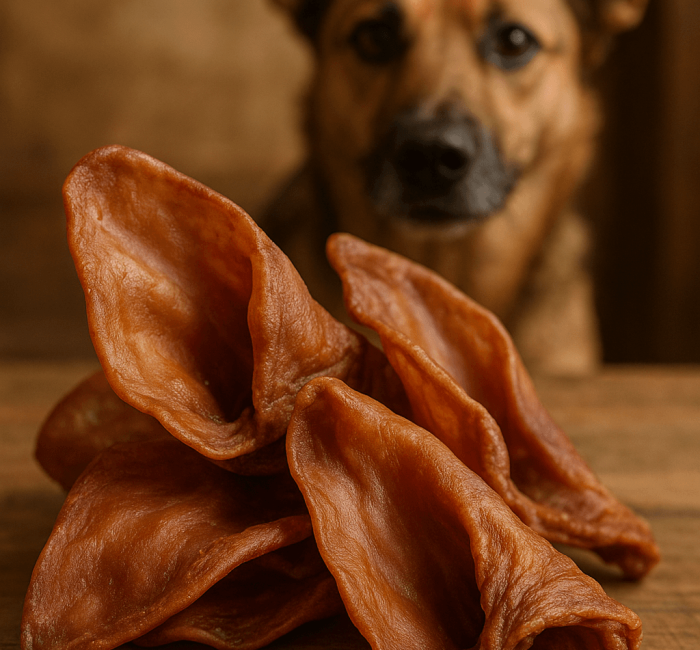Pig Ears for Dogs: Safe or Not?

If you’ve browsed treat aisles or explored options online, you’ve likely noticed those crispy, chewy snacks everyone raves about. They’ve built a strong fanbase — owners love giving them, and furry companions can’t seem to get enough. But popularity brings questions: Are they safe? Are they a smart choice? Can they be offered regularly?
This guide explores these treats in full—covering benefits, potential risks, and key details in between. Whether introducing them for the first time or ensuring proper use, this breakdown provides all essential information.
What Are Pig Ears for Dogs?
They’re exactly what you’d imagine — actual ears from pigs that have been dried through baking or dehydration, giving them a firm, crunchy texture. You’ll often see them offered whole, sliced into strips, or even infused with a smoky flavor. Unlike some other snack options made from heavily processed leftovers, these stand out as a straightforward, single-ingredient choice.
Some brands toss in extra flavor or preservatives, while others keep things as natural as possible. Since they’re made from cartilage and skin, the texture hits that sweet spot — not too tough, not too squishy — which makes them a favorite for many.
Why Do Dogs Love Them?
Its chewy texture provides something to gnaw on, keeping jaws engaged and muscles active. High fat content adds flavor and satisfaction, enticing pets to return for more. Natural aroma grabs attention instantly, even if humans don’t find it appealing. Plus, it lasts a long time, maintaining interest during extended play—especially for small to medium-sized companions.
Nutritional Profile of Pig Ears
These snacks aren’t meant to replace a full meal, but they provide a bit of extra nutrition. Here’s a general overview of what one typically offers (with some variation depending on the source):
| Nutrient | Amount |
|---|---|
| Calories | 180–220 |
| Protein | 15–20g |
| Fat | 8–12g |
| Fiber | <1g |
| Carbohydrates | 0g |
Key Takeaways:
They’re rich in protein and fat, providing a calorie-packed snack full of energy.
They have zero carbs, which fits perfectly with their natural meat-loving instincts.
These treats should be offered sparingly due to high fat content, particularly for pets that are overweight or prone to pancreatitis.
Why This Treat Is Great for Your Furry Friend
When given in moderation, they provide several benefits:
Dental Health
Gnawing on crunchy items can help remove buildup on teeth, like plaque and tartar. Although this doesn’t replace regular brushing, it supports cleaner teeth and fresher breath by reducing residue and preventing excessive accumulation. Regularly including these in their routine can make a noticeable difference in oral upkeep over time.
Mental Stimulation
Gnawing on this treat keeps pets mentally engaged and provides a productive outlet for extra energy. It’s a simple way to keep them entertained while curbing restlessness, especially for always-on-the-go companions.
Natural Source of Collagen
They contain natural collagen, which helps support joint function, improve coat quality, and maintain skin elasticity.
Good Alternative to Rawhide
Unlike rawhide, these treats are easier to digest, don’t expand in stomach, and are less likely to cause blockages when given appropriately.
Are Pig Ears safe for Your Pet?
Let’s get to the key question: Are these snacks truly a good choice for a furry companion? Many owners grab them thinking they’re an easy way to keep pets occupied, but reality isn’t always that simple. It’s important to look beyond marketing and consider actual ingredients, production methods, and how a pet might react. What seems like a convenient treat can sometimes bring surprises, so understanding both benefits and potential risks is crucial before offering one.
Truth: It Depends
While many four-legged companions enjoy these treats without issues, there are potential downsides to be aware of. Some pets handle them well, but for others, they can cause problems if precautions aren’t taken.
Risk #1: Bacterial Contamination
In 2019, CDC and FDA linked these treats to salmonella outbreaks affecting both animals and humans, prompting recalls.
Tip: Choose products from trusted U.S. manufacturers that follow strict quality standards and monitor every production step. This ensures treats are handled properly and made consistently.
Risk #2: Choking Hazard
Pets that gnaw aggressively or smaller companions may break treats into large pieces that can lodge in the throat, causing dangerous blockages. Anything prone to splintering should be given with caution.
Tip for Responsible Use: Supervise pets while they enjoy treats. Step in if pieces are too large or if anything seems off. Watching ensures a safe, enjoyable experience.
Risk #3: Digestive Upset
Delicate stomachs may react to rich treats with vomiting or discomfort, affecting energy or mood.
Tip: Start with a small portion and observe reactions—stomach upset, unusual behavior, or lack of interest are signals to adjust. Gradually increase amounts if tolerated, allowing their system to adapt.
Risk #4: Obesity
High calorie content can lead to weight gain if given regularly.
Tip: Limit treats to occasional portions—once or twice a week, depending on pet size and condition. This keeps them enjoyable without unnecessary strain.

Choosing High-Quality Pig Ears
Not every product in this category delivers the same quality. Some are heavily processed, while others are made more naturally. To make a smarter choice, focus on key factors: ingredients, preparation method, absence of artificial additives, and sourcing from a trusted manufacturer.
Made in USA
It’s best to steer clear of low-quality imports since some of them go through processing methods that involve harsh chemicals, which can end up being harmful. Always choose options from reliable sources where you know how they’re made and what goes into them.
Single-Ingredient
Best choices are those that come pure and natural, with nothing extra—no additives, preservatives, or artificial flavorings.
Natural or Slow-Roasted
Avoid serving items in a deep-fried version. Cooking this way introduces extra oils that increase fat and calorie content, which can strain digestion and offer little to no nutritional advantage. Opting for baking, steaming, or lightly sautéing provides a gentler alternative while preserving flavor and nutrients.
Uniform Size
Select items that fit their size. Oversized portions can feel overwhelming for smaller individuals and may be difficult to manage effectively, leading to frustration or wasted effort. Choosing appropriately sized options ensures easier handling, safer use, and a more comfortable experience overall.
Trusted Brands for High-Quality Chews:
Pig Ears vs. Other Dog Chews
Let’s examine how these options compare with several popular alternatives currently available. By reviewing key features, performance outcomes, and user feedback side‑by‑side, one can clearly see which choices deliver greater value or convenience compared with competing picks.
| Treat Type | Digestibility | Fat Content | Dental Benefit | Risk Level |
|---|---|---|---|---|
| Pig Ears | High | High | Moderate | Medium |
| Rawhide | Low | Moderate | High | High |
| Bully Sticks | High | Moderate | High | Medium |
| Antlers | Very Low | Low | High | High (tooth fracture) |
| Yak Chews | High | Low | Moderate | Low |
Verdict: These treats often outperform rawhide in terms of digestibility and reduced risk of complications. That said, their richness can make them unsuitable for every animal, particularly those with sensitive digestion or restricted dietary needs. Choosing them wisely ensures enjoyment without causing discomfort or overindulgence.
How to Feed Them Safely
Tips for making snack time safe and enjoyable for four-legged friends:
Supervise constantly: Never leave them with a treat unattended. Close observation ensures they enjoy it safely and prevents any mishaps.
Serve in moderation: Limit to one treat per serving, no more than once or twice a week. This allows enjoyment without overindulgence.
Store correctly: Keep in a cool, dry spot inside an airtight container to maintain freshness.
Introduce gradually: Offer half a piece initially so they can adjust slowly. Watch their response to ensure it doesn’t cause discomfort. Increase portion size only when they handle it well.
Choose appropriate size: Pieces should be easy for them to manage. Oversized treats can be challenging to gnaw and may lead to frustration or strain. Match portions to jaw strength and overall size for a comfortable experience.
What the Experts Say
We consulted several experts to get their perspective on offering these types of treats to four-legged companions:
Dr. Kate Montgomery, DVM
“Occasional use is generally fine, provided treats come from a trusted source. Ensuring cleanliness and safety is key. I always recommend checking for USDA approval before selecting any product.”
Dr. Josh Singh, DVM
“These treats suit adult animals without a history of pancreatitis. They aren’t ideal for young ones still growing or older companions with dental concerns, as they can be too tough on teeth and gums.”
Dr. Laura Chen, Holistic Vet
“I prefer dehydrated, all-natural options with no added ingredients. Offering them occasionally provides a tasty snack and a natural boost of collagen, making it a beneficial choice when used thoughtfully.”
Are They Good for Puppies?
Short answer: Not really.
- They have delicate stomachs when they’re young, which means what goes into it needs to be gentle and easy to digest. Even small changes in what they eat can upset their tummy, so it’s important to be mindful of what they nibble on.
They are more likely to get stuck in the throat, which can cause serious problems if not watched closely. It’s important to keep an eye on them while they’re enjoying it and intervene quickly if it gets lodged.
Their teeth continue to form and strengthen as they grow. This process happens gradually, with new layers emerging and existing structures becoming more robust. Regular attention to how they interact with objects or toys during this stage can support proper alignment and overall oral development. Watching for signs of discomfort or difficulty while gnawing can provide insight into their progress.
If you choose to give one, break it into tiny pieces and watch closely while it’s being enjoyed. There are also gentler options that are much easier to handle, like soft little bites meant for nibbling or chilled carrot sticks that deliver a satisfying crunch without any worry.
Are They Safe for Seniors?
Even as pets get older, they can still find enjoyment in these snacks, but extra caution is needed. Their teeth and digestion may not handle them as easily as before, so it’s wise to monitor how they respond and adjust accordingly.
Weaker teeth: If their teeth are on the fragile side, they might struggle with harder snacks. They could find it uncomfortable or even painful to break down something that’s too firm, so softer options might be easier for them to manage.
Slower digestion: High fat may cause gastrointestinal upset.
Weight gain: They tend to slow down with age and aren’t as energetic as they used to be.
Before introducing this snack to your senior furry friend, it’s important to consult your veterinarian. They can provide guidance on whether it’s appropriate, taking into account age, dietary needs, and any underlying conditions. This step ensures your companion enjoys it without complications and helps you make an informed decision tailored to their individual needs.
Pig Ear Alternatives
If those options don’t suit your four-legged companion, there are plenty of other choices to consider. You can explore alternatives that are easier to digest, gentler on teeth, or simply more enjoyable for their taste buds. Some options come in softer textures, while others offer long-lasting engagement to keep them busy and satisfied. Paying attention to their preferences and needs can help you find something they’ll really enjoy without any fuss.
Cow ears – These cow ears are naturally lower in fat, making them a lighter option. They provide a long-lasting texture that keeps them occupied and engaged for quite a while. With their sturdy structure, they can help strengthen jaws and keep them busy without adding extra weight to their diet.
Duck feet – They love duck feet – perfect for smaller companions to enjoy as a flavorful snack.
Beef trachea – Rich in glucosamine, this option naturally supports joint strength. Its firm texture keeps four-legged friends engaged, encouraging natural gnawing behavior while providing long-lasting enjoyment.
Bully sticks – High in protein and gentle on digestion, these treats are easy to enjoy without causing any discomfort.
Crunchy dental treats – Experts often recommend certain crunchy options designed to support oral hygiene. Brands like Greenies help reduce buildup on teeth and promote fresher breath. These treats encourage gnawing, which can assist in cleaning teeth and massaging gums, all while being enjoyable. Available in various sizes, they can match different breeds and serve as a convenient addition to a routine aimed at maintaining a bright, clean smile.
Frequently Asked Questions (FAQs)
Could these items upset their stomach?
Absolutely, they might react. For a companion not used to foods that are high in fat, introducing this kind of snack can sometimes cause an upset stomach. You might observe looser stools, occasional tummy gurgles, or mild digestive disturbances as their system adjusts to the richer ingredients. It’s wise to start gradually—give just a small piece at first and keep a close eye for any signs of discomfort before offering it more frequently.
How often can these items be offered without causing issues?
For most companions, once or twice a week is generally safe. Offering them more frequently can increase calorie intake, potentially leading to unwanted weight gain or digestive upset. Adjust portions based on size, activity level, and individual tolerance.
Are these items available in a natural, uncooked form?
No, these items usually undergo a preparation process before reaching pets. They are often baked, smoked, or dehydrated, which extends shelf life and reduces risk of harmful bacteria. This processing also improves firmness and texture, making them more satisfying to gnaw.
Can these treats be made at home?
Yes, though preparation requires patience and careful attention. Slowly baking or dehydrating raw ingredients at low temperatures for several hours ensures proper drying and safe chewing. This method preserves natural qualities while lowering risk of contamination.
What if a treat is swallowed whole?
Immediate action is essential. Contact a veterinarian without delay for guidance. Meanwhile, observe carefully for signs of choking, gagging, vomiting, or discomfort. Large pieces can block passageways or pose a choking risk, so professional advice is critical.
Pros and Cons of Giving Pig Ears
Pros:
All-natural and single-ingredient
Made from just one source, this option is completely natural with no added or artificial components. Its simplicity ensures you always know exactly what is being offered.
Highly appealing
Flavor and texture make it irresistible, keeping pets engaged and excited during snack time. It turns every moment into something they look forward to.
Promotes oral cleanliness
Firm texture encourages gnawing that naturally reduces buildup on teeth, helping maintain cleaner mouths over time.
Mentally stimulating
Chewing and nibbling keeps minds sharp and focused. This activity provides entertainment, channels energy productively, and offers a sense of accomplishment, turning a simple treat into a stimulating challenge.
Widely available: This option can be found in most stores or online, making it easy to include in your daily routine without hassle.
Cons:
High Fat Content
Some of these products contain a significant amount of fat. Regular consumption may lead to unwanted weight gain, placing extra strain on joints and internal organs over time. This makes them less suitable for animals prone to weight issues.
Risk of Contamination
If not processed or stored properly, these items could carry bacteria or other harmful substances. Even one contaminated piece could cause illness, so caution is important when selecting and offering these treats.
Potential Choking Hazard
Shape, size, or firmness may cause fragments to break off unexpectedly, posing a risk of getting lodged in the throat. Smaller or inexperienced animals may struggle with managing tough or rigid items safely.
Not Ideal for Young or Older Animals
Very young or senior animals may have difficulty with tough textures. Young ones may not yet have fully developed jaws, while older ones may have weaker teeth, making these treats unsuitable for these age groups.
May Cause Digestive Upset
Some individuals may experience upset stomach, vomiting, or diarrhea after consuming these treats. High fat content and density can be hard to process, especially for those with sensitive digestion.
Conclusion
These indulgences can provide fun and stimulation if offered thoughtfully. They encourage gnawing, occupy the mind, and offer a satisfying texture experience. However, they aren’t appropriate for every animal. High fat content, possible contamination, and choking risk mean careful selection and supervision are essential.
For animals with strong digestion, a balanced weight, and an enjoyment of gnawing, these treats can be a delightful occasional reward. Attention to brand, portion size, and frequency ensures safety and enjoyment.
Moderation makes moments special — savor interactive, cheerful snack times while keeping safety in mind.



